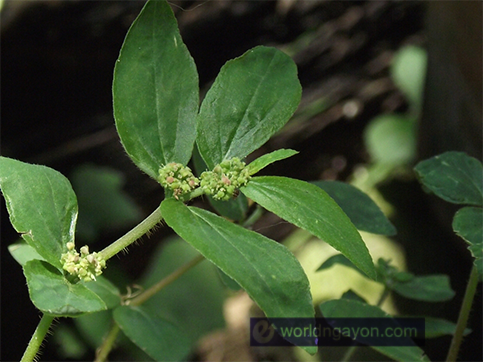Tawa-tawa (Euphorbia hirta), also known as “gatas-gatas,” is a hairy herb grown in open grasslands, roadsides and pathways. This indigenous plant is claimed to have a curative effects on dengue patients as being backed up by personal testimonies, it became one of the most popular “folkloric medicine” for dengue in the Philippines. However, despite its widespread use, there is no evidence to support this claim.

Intent of finding out the truth behind tawa-tawa’s curative properties, students of the University of Sto Tomas (UST) – Faculty of Pharmacy, Manila City conducted a study entitled “Investigation of the anti-thrombocytopenic property of euphorbia hirta linn (Tawa-Tawa) decoction in rat models. The study aimed to verify the effects of tawa-tawa to a dengue hemorrhagic fever (DHF) patient showing a symptom of thrombocytopenia (low platelet count due to excessive bleeding).
In the study, the students used certain drugs to induce thrombocytopenia on rat models, to mimic dengue hemorrhagic fever. They administered tawa-tawa decoction to the sample groups and collected blood samples to check for platelet count, bleeding time (duration of bleeding), and blood clotting times in several stages of the experiment.
Results showed that platelet count increased to 47% depending on the drug used to induce thrombocytopenia. Bleeding time was reduced up to 62% while blood clotting time decreased to 58% compared to the control groups.

Based on the results, students concluded that administering tawa-tawa decoction to animal models help improve their healing mechanism. Tawa-tawa promotes cell production, and prevents platelets destruction. Likewise, the improvement in the cell bleeding time and clotting time provided evidence that the indigenous plant can preserve and promote the hemostatic function of platelets.
The students also discovered phenolic compounds in tawa-tawa, active ingredients suspected to be responsible in the increased platelet counts of tested animals. In an interview, Mr. Ryan Justin Raynes, one of the student researchers said that through a phenolic determination assay, they were able to identify ‘minute’ phenolic compound in tawa-tawa samples. “Although there were small amount of phenolic compound in tawa-tawa, this was sufficient to exert effect promoting quality and quantity of platelets,” Mr. Raynes said.
Because of the study’s significant findings, it won the first prize in the PCHRD – Gruppo Medica Award held during the 6th Philippine National Health Research System (PNHRS) Week held at Sofitel Manila last 10 August 2012. PCHRD – Gruppo Medica Award is given to undergraduate students engaged in herbal medicine research that have potential for practical or commercial applications.
Researchers included in this study were: Ranya Alkhirisi, Jhamaica Alanis, Kaye Edmerose Alas, Marc Oliver Armeña, Angeline Barrosa, James Victor Gan, Anna Andrea Sabado, Christanne Deanne Santiago and Leah Corinna of the Faculty of Pharmacy, UST, Sampaloc Manila. This article is also posted at PCHRD website.

